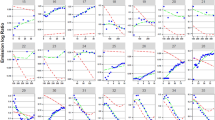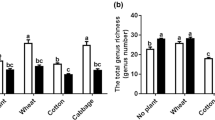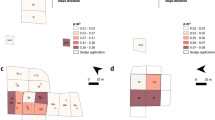Abstract
WHILE investigating the removal of leaves by earthworms from the soil surface of some apple orchards at Wisbech (Cambs.) an estimate of the population of Lumbricus terrestris was needed because it seemed to be the only species present that pulled apple leaves into its burrows. L. terrestris burrows deeply in the light, well-drained soil of the Wisbech area, and a population estimate made by removing and hand-sorting soil samples was impracticable because of the depth of the burrows into which the worms retreat when soil samples are removed. The permanganate method used by Evans and Guild1 has been shown by Svendsen2 greatly to under-estimate the population and my tests at Wisbech confirmed this.
This is a preview of subscription content, access via your institution
Access options
Subscribe to this journal
Receive 51 print issues and online access
$199.00 per year
only $3.90 per issue
Buy this article
- Purchase on Springer Link
- Instant access to full article PDF
Prices may be subject to local taxes which are calculated during checkout
Similar content being viewed by others
References
Evans, A. C., and Guild, W. J. McL., Ann. App. Biol., 34, 307 (1947).
Svendsen, J. A., Nature, 175, 864 (1955).
Waters, R. A. S., N.Z.J. Sci. Tech., 36, A, 516 (1955).
Author information
Authors and Affiliations
Rights and permissions
About this article
Cite this article
RAW, F. Estimating Earthworm Populations by Using Formalin. Nature 184, 1661–1662 (1959). https://doi.org/10.1038/1841661a0
Issue Date:
DOI: https://doi.org/10.1038/1841661a0
This article is cited by
-
Applications of physical methods in estimation of soil biota and soil organic matter
Soil Ecology Letters (2020)
-
Litter quality, dispersal and invasion drive earthworm community dynamics and forest soil development
Oecologia (2018)
-
Extraction of earthworm from soil by different sampling methods: a review
Environment, Development and Sustainability (2016)
-
Seasonal dietary shifts and food resource exploitation by the hog badger (Arctonyx collaris) in a Chinese subtropical forest
European Journal of Wildlife Research (2015)
-
Earthworms Reduce Biotic 15-Nitrogen Retention in Northern Hardwood Forests
Ecosystems (2015)
Comments
By submitting a comment you agree to abide by our Terms and Community Guidelines. If you find something abusive or that does not comply with our terms or guidelines please flag it as inappropriate.



